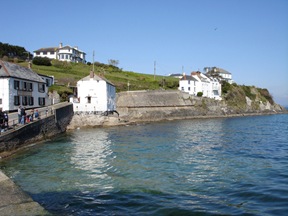
For the text of the ballad of Charlotte Dymond, click HERE.
All quotes are taken from the excellent write up about the story of Charlotte Dymond by accomplished crime writer Linda Stratmann.
Who was Charlotte Dymond?
She was an 18 year old domestic servant who was murdered on Bodmin Moor in Cornwall, UK. Her partner, Matthew Weeks, was hanged for her murder in accordance with the law. She was found with her throat cut, having lain undiscovered for several days in a concealed ditch. Charlotte was around 18, an illegitimate child with black hair and pale skin. In addition:
Charlotte, ... was attractive and smartly dressed [and] was reputed to be a flirt.
When did she die?
Charlotte was killed on 14th April 1844. Her ghost is said to have been seen on 14th April in various years, wearing the clothes she was in the day she died.
Did Mathew Weeks indeed murder her?
Nobody witnessed the murder. There was a considerable amount of circumstantial evidence linking Matthew with her murder. His clothes were very muddy and were ripped, indicating a struggle with Charlotte in the muddy marsh.
Mrs Peter was surprised to find that Matthew’s blue stockings that he had worn the previous day were muddied up to the knees. It had rained on the Sunday but not, she felt, enough to get the stockings into that mess.* The mud, she observed, was like that found in the turf-pits on the moor.
He was seen walking out onto the moor with Charlotte and various eyewitnesses saw a couple matching their description (particularly Matthew’s limping gait) at various points walking on the moor thereafter. Matthew however returned alone, unable to account for her disappearance. He later fled to Plymouth where he was ultimately arrested. Thereafter, Mathew changed his story at various times during police questioning.
Is it all that simple?
No. There are various theories surrounding the death. For instance, crime writer, Pat Munn, advanced the theory that she might have committed suicide, believing herself to be pregnant outside of marriage. A post mortem showed her not to be pregnant, though she was not a virgin either. In any event, there was no reason to suggest she thought she might be pregnant and, even if she had, it is a highly unusual means for someone to take their own life. There is also the suggestion that her lover, Thomas Prout, may have killed her although what motive he may have had remains unclear.
Why was suicide discounted?
The nature of the wound, principally. It was totally inconsistent with typical wounds inflicted by suicide and suggested the attacker came from behind:
The wound that had ended Charlotte’s life had been terrible indeed. It was eight and a half inches in length, starting on the left side of her neck and extending all the way around to the right. It passed two and a half inches below her ear and was two and a half inches deep. It was deeper on the left side, where the whole of the soft tissues were divided right down to the bone. The windpipe was completely divided, the oesophagus partly. The instrument had even gone between two vertebrae partially separating them. It was clear that great force had been used. The roughness of the sides of the wound meant that the instrument was unlikely to have been very sharp. [A local doctor] did not think it possible that she could have inflicted the wound herself.*
Was a love triangle the root of the motive for Charlotte’s murder?
In all probability, yes:
Charlotte and Matthew had been seeing each other, even before she came to work at Penhale. There was, however, a rival for Charlotte’s affections.* Thomas Prout, aged about 26 was a nephew by marriage of Mrs Peter, and lived some four miles away. Matthew had worked with Prout before, and they had not got on well together. A few days after Lady Day, Prout visited Penhale, and John Stevens overheard words between him and Matthew. Prout had said that he was thinking of moving to Penhale, and if he did, he would soon deprive Matthew of his girlfriend.*
The thought of losing Charlotte, coupled with the possibility of her infidelity, arguably drove Matthew to kill her.
Was the evidence against Matthew overwhelming?
Nobody saw the murder take place, but the circumstantial evidence against him was compelling. The main points were as follows:
- Matthew’s suspicious behaviour after returning to the farm (principally his failure to account for Charlotte’s whereabouts);
- That his clothing was muddied and torn, indicating a struggle had taken place on the moor;
- The fact he fled the farm when questioned by Mrs Peter;
- That he was the last person to have been seen with Charlotte by witnesses;
- Prints in the marsh by Charlotte’s body were felt to be a match with Matthew’s shoes; and
- That he changed his story during police questioning.
Matthew was illiterate. Whilst in jail, he was said to have dictated two letters. One was to Mrs Peter and one was to his family. The letter to his family detailed how he wanted his property to be dealt with after he died as well as containing an apparent confession.
"I hope young men will take a warning by me and not put too much confidence in young women, the same as I did; and I hope young females will take the same by young men. I loved that girl as dear as I loved my life; and after all the kind treatment I have showed her, and then she said she would have nothing more to do with me. And after this was done, then bitterly I did lament, thinking what would be my end. And I thank the judge and jury too, for they have given me no more than was my due."
He is also said to have dictated a separate confession in which he explicitly admitted the murder. However, Linda Stratmann suggests this ‘confession’ could have been bogus as the style of writing and vocabulary used was considerably more sophisticated than that used in the letters.
However, as Matthew was illiterate, nobody really knows whether the letters and separate confession were authentic.
Why did Charles Causley write the ballad?
Good question. While it’s impossible to know the precise reason why Causley wrote the ballad in1974/1975, we can certainly speculate. Firstly, Charles Causley was himself Cornish and the story of Charlotte Dymond and her subsequent haunting by her ghost on Bodmin Moor have become firmly ingrained in Cornish folklore. Given the nature of the story, it is likely Causley felt moved to do so by pure tragedy of the tale. The final stanza of the ballad hints towards his personal opinion as to the culpability of Matthew in which he is regarded as being as much a victim as was Charlotte.
This is less to do with the fact Causley believed Matthew was innocent of Charlotte’s murder but rather that Matthew’s low intelligence and ill-fortune in life made him more susceptible to be struck by a jealous rage at the thought of Charlotte with another man. The ballad also suggests that Causley believed the naive and dim-witted Matthew may have been exploited by the police.
N.B. * My emphasis.

 I was amused to see the proposed new logo for the Office for Government Commerce in the comment section of The Times today. Costing £14,000 (I could have mocked one up in Photoshop for just a snip of that price) the new, sleek, modern logo is great, until turned 90 degrees clockwise.
I was amused to see the proposed new logo for the Office for Government Commerce in the comment section of The Times today. Costing £14,000 (I could have mocked one up in Photoshop for just a snip of that price) the new, sleek, modern logo is great, until turned 90 degrees clockwise.


























